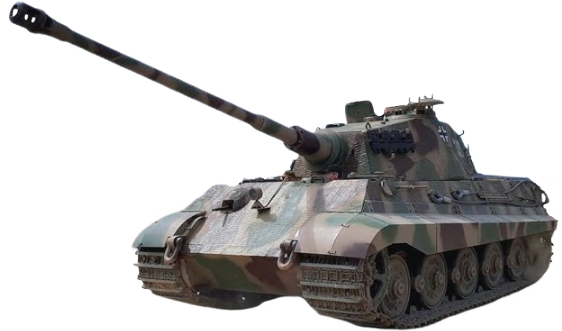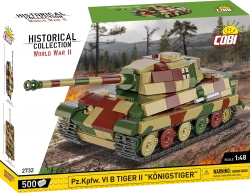
You know that:
- Ferdinad Porsche, a native of Vratislavice nad Nisou, was involved in the development and designed the combined diesel-electric drive.
- However, the standard Henschel solution with a petrol engine went into series production.
- Several stands were equipped with an extremely high quality and advanced optical sight, which allows to shoot accurately even at long range.
- The KwK 43 L/71 gun was able to penetrate 180mm thick armour at a distance of 500 metres.
- The Royal Tigers were first deployed in August 1944 on the Eastern Front.
- Despite the fact that it was the most powerful tank in World War II, 11 machines were destroyed in combat or stuck in the mud during the first days.
- The TIGER II tank found its competitor only in the Soviet IS-2, or in the Ardennes in the American M26 Pershing tank.
- A total of 492 pieces were produced.
- Production was so complex and expensive that the German economy simply could not produce more of them.
- On May 9, 1945, when the world celebrated the end of the war, there was still fighting in Bohemia near Trebon.
- A group of 3 Tigers tried to break into the American captivity and one command Königstiger was stranded in a waterlogged meadow where it became a local attraction for several weeks.
Technical parameters:
- dimensions: length 10,29 m (7,38 m without gun), width 3,76 m, height 3,09 m
- weight 68 500 kg
- 185 mm frontal armour, 80 mm side, 80 mm rear
- power unit petrol 12 cylinder 23.1 l Maybach HL230 P30 engine with 515 kW
- top speed 38 km/h on the road and 15-20 km/h off-road
- fuel tank capacity 860 l
- 170 km on the road and up to 120 km off-road
- main weapon KwK 43L/71 cannon 88 mm calibre
- secondary weapon 2x machine gun MG 34 calibre 7,92 mm
- crew commander + gunner, loader, driver, radio operator
From the memoirs of tank commander George Diers 1945:
"We knew very well that all was lost, but our determination not to surrender Berlin without a fight drove us forward. While the Soviets were pounding on the city gates, our Königstiger was sent to defend the train station in the direction of Anhalter Bahnhof. The task was to prevent the enemy army from entering the city by rail. On the morning of April 18, we managed to destroy several T-34s and force the Russians to withdraw. But not for long. That very evening, a deflected shell hit the right belt of our tank. At night, the fighting subsided and we managed to repair the belt using the tools we had at our disposal. The last combat action for us was the defense of the Reichstag. We waited in the cover of the Kroll Theater from where we wanted to launch a final attack against the rolling Red hordes. It all ended after a few meters when we hit a mine hidden under a thick layer of dust and small debris. None of the crew were hurt, but it was a bitter end for us."




